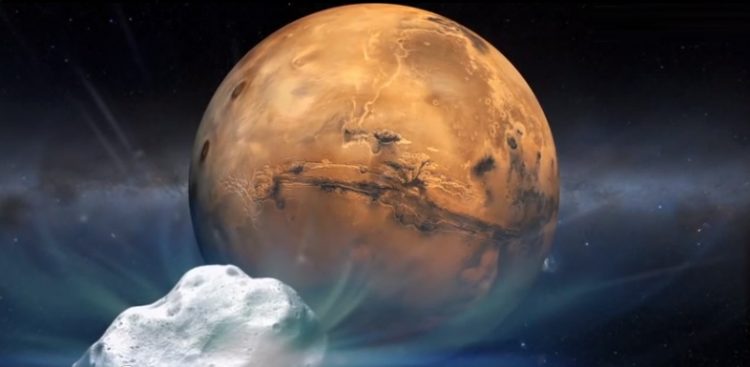Swedish instrument will make measurements when a comet passes Mars

Comet Siding Spring and Mars Artist's impression: NASA
“Noone has before made measurements when a comet passes so close by a planet”, says Associate Professor Mats Holmström at the Swedish Institute of Space Physics in Kiruna, Sweden.
The comet Siding Spring will pass by Mars at a distance of only 140 000 km, about a third of the distance from the Earth to the Moon, by way of comparison. The outer parts of the comet's thin atmosphere will collide at high speed (56 km/sec) with the atmosphere of Mars.
“We expect that gas and dust from the comet will impact on the Martian atmosphere, which will be temporarily heated and will expand”, says Mats Holmström. “We should be able to see that with our instrument”.
The Swedish Institute of Space Physics (IRF) has Principal Investigator responsibility for the satellite instrument ASPERA-3 which is an international collaboration with participants from some 15 research groups from about 10 countries. ASPERA-3 on board the measures how charged particles from the sun, the so-called solar wind, influences the atmosphere of Mars. Mars Express was lauched by the European Space Agency (ESA) and has been orbiting Mars since 2003.
More information:
Assoc. Prof Mats Holmström, scientist, IRF, tel. +46-980-79186, +46-70-211 1138, mats.holmstrom*irf.se
Rick McGregor, information office, IRF, tel. +46-980-79178, +46-70-276 6020, rick.mcgregor*irf.se
http://www.irf.se/?dbfile=Mars%20Express%20and%20ASPERA-3&dbsec=Administrati… Instrument ASPERA-3 and satellite Mars Express
http://blogs.esa.int/mex/category/comet-siding-spring/ Pages on Comet Siding Spring: ESA
http://mars.nasa.gov/comets/sidingspring/%20%20%20%20 Pages on Comet Siding Spring NASA
Media Contact
All latest news from the category: Physics and Astronomy
This area deals with the fundamental laws and building blocks of nature and how they interact, the properties and the behavior of matter, and research into space and time and their structures.
innovations-report provides in-depth reports and articles on subjects such as astrophysics, laser technologies, nuclear, quantum, particle and solid-state physics, nanotechnologies, planetary research and findings (Mars, Venus) and developments related to the Hubble Telescope.
Newest articles

A universal framework for spatial biology
SpatialData is a freely accessible tool to unify and integrate data from different omics technologies accounting for spatial information, which can provide holistic insights into health and disease. Biological processes…

How complex biological processes arise
A $20 million grant from the U.S. National Science Foundation (NSF) will support the establishment and operation of the National Synthesis Center for Emergence in the Molecular and Cellular Sciences (NCEMS) at…

Airborne single-photon lidar system achieves high-resolution 3D imaging
Compact, low-power system opens doors for photon-efficient drone and satellite-based environmental monitoring and mapping. Researchers have developed a compact and lightweight single-photon airborne lidar system that can acquire high-resolution 3D…





















